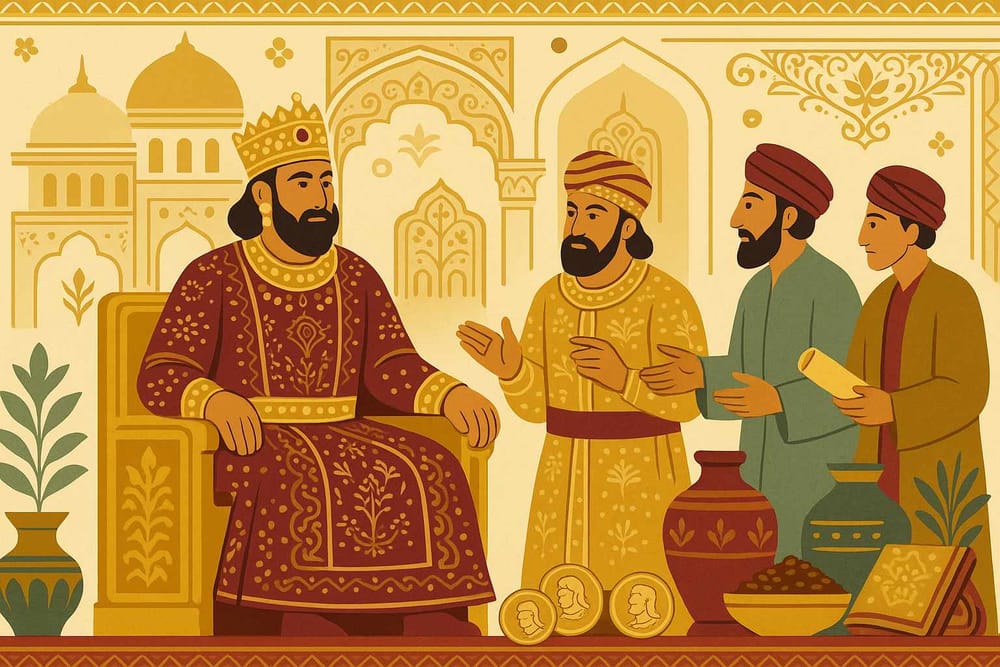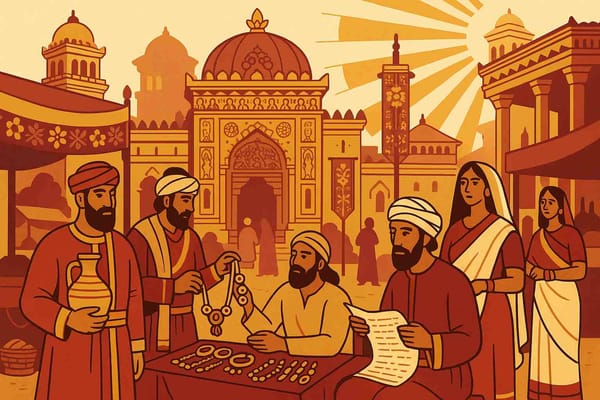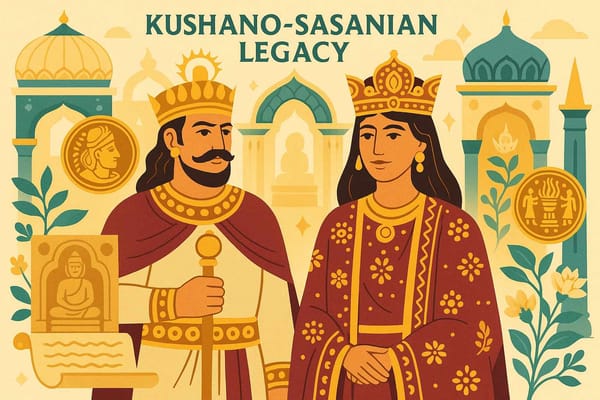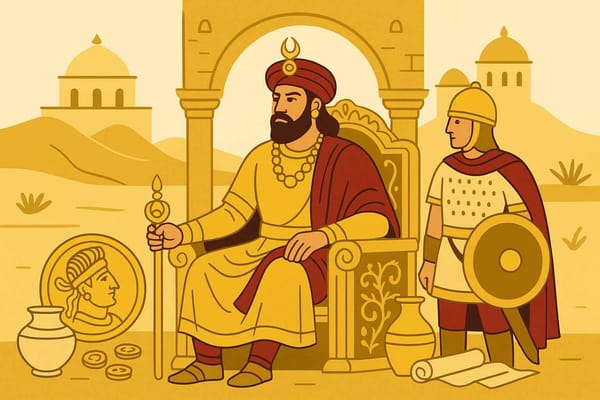
Kushano-Sasanians- A Forgotten Era of History Explained
History, as we often read it, is a grand narrative of mighty empires and legendary conquerors. But sometimes, the most fascinating tales are hidden in the folds, in the chapters that speak not of conquest, but of confluence—a beautiful sangam of cultures. One such forgotten story is that of the Kushano-Sasanians, or the Indo-Sasanians, a kingdom that blossomed at the crossroads of ancient worlds, weaving together the threads of Persian and Indian heritage.
Let’s journey back in time, to an era where art, faith, and trade created a legacy that, while often overlooked, still echoes in the heart of Central and South Asia. This isn't just a history lesson; it's the discovery of a shared virasat (heritage) that shaped our world in more ways than we imagine.
A New Power Rises from the Old
It's natural to ask, how did this unique Kushano-Sasanian power actually come to be? Their story begins around 225 CE, a time of great change. The once-mighty Kushan Empire, which had ruled over vast territories, was in decline. Seizing this moment, the formidable Sasanian Empire of Persia, under ambitious rulers like Ardashir I, expanded eastward.
They captured vital regions like Bactria, Gandhara, and Sogdiana (in modern-day Afghanistan and Central Asia). But this was not just a simple takeover. The Sasanian governors appointed to rule these lands adopted the title "Kushanshah," meaning "King of the Kushans." This wasn't just a political move; it was a mark of respect for the local culture, creating a unique sub-kingdom that blended Sasanian administration with Kushan traditions.
A Melting Pot of Faith and Art
The true magic of the Kushano-Sasanian era lies in its incredible cultural fusion. It was a time when diverse beliefs and artistic styles didn't just coexist; they conversed and created something entirely new. You might wonder, what were their most notable achievements? The answer lies in this beautiful synthesis.
- Artistic Harmony: The art from this period is a breathtaking blend of Hellenistic (Greek), Persian, and classic Indian styles. Imagine sculptures and architectural designs where Persian motifs gracefully merge with Indian aesthetics. This vibrant exchange reminds us of the rich artistic traditions that flourished across India, like the intricate arts and crafts found in the heritage of Mewar.
- A Confluence of Beliefs: This era was a testament to religious harmony. Zoroastrianism, the faith of the Sasanians, flourished alongside Buddhism and Hinduism. Buddhist monasteries received royal patronage, leading to new developments in Buddhist art and philosophy. This peaceful coexistence of faiths is a powerful lesson from our past.
- Stories Told in Coin: If you want to see their legacy in your hand, look no further than their coins. The Kushano-Sasanians minted their own currency, which beautifully captures their dual identity. One side might feature a Sasanian-style ruler with a majestic headdress, while the other could depict a Zoroastrian fire altar or, incredibly, Lord Shiva with his beloved Nandi. These coins, with legends in Brahmi, Pahlavi, and Bactrian scripts, are solid proof of their blended world.
Seeing these ancient depictions of our deities reminds us of their timeless presence and significance. At Bhaktilipi, we are deeply passionate about preserving these very stories and traditions, making them accessible for you to explore and connect with. Discover our collection of timeless literature on the Bhaktilipi platform.
Masters of the Ancient Silk Road
The Kushano-Sasanian kingdom was strategically located, controlling the vital arteries of the legendary Silk Road. This wasn't just a trade route; it was the ancient world's information superhighway, connecting the Roman Empire in the west with India and China in the east.
Under their rule, great cities like Kabul, Balkh, Herat, and Merv became bustling hubs of commerce and culture. Caravans laden with silks, spices, gems, and other precious goods passed through their domain, bringing immense prosperity. But more importantly, they carried ideas, philosophies, art, and stories, making the Kushano-Sasanian kingdom a true bridge between civilizations.
The Fading Light: A Kingdom's Final Chapter
Like all great empires, the Kushano-Sasanian era eventually faced challenges. There was even a period of internal strife when a powerful Kushanshah named Hormizd I rebelled against the main Sasanian Emperor, Bahram II, though his attempt was unsuccessful.
The final blow came around 360-370 CE with the invasion of the Kidarite Huns, a nomadic people from the north who conquered much of their territory. Though the Sasanians later regained some control, the golden age of the Indo-Sasanians had passed, eventually fading into the larger Sasanian Empire before its final collapse under Arab attacks in the 7th century.
This often leads people to ask, why is the Kushano-Sasanian era considered a forgotten part of history? It's largely because it was a transitional period, sandwiched between the Kushans and the rise of other great powers like the Guptas in India. With limited written records, their story has often been pieced together through their remarkable coinage and artifacts, leaving them as a lesser-known, but no less important, chapter in our shared history.
The Echoes of a Forgotten Kingdom
The Kushano-Sasanians may not have the fame of the Mauryas or the Mughals, but their legacy is profound. They teach us that history is not always about conflict, but also about connection and creation. They were masters of blending traditions, skilled administrators of diverse peoples, and guardians of the routes that allowed cultures to mingle.
By exploring their story, we honor a forgotten chapter of our past and learn valuable lessons about unity and cultural respect. Their history is a beautiful reminder of the interconnected tapestry of civilizations that shaped the world we live in today, a pattern of cultural exchange that defines the very soul of India. The spirit of this era, a journey through time and myth, shows us how different streams of culture can come together to form a mighty river.
About Us
Bhaktilipi is your sacred space online, a digital haven for timeless devotional literature and stories. We lovingly gather works from different regions and languages, including rare and beautiful texts, to preserve our rich spiritual heritage. By digitizing these treasures, we ensure that our traditions remain vibrant and accessible for generations to come.
We don't just archive; we reimagine sacred texts, devotional poetry, and soul-stirring stories to connect deeply with you, today's reader, while honouring their ancient roots. Our curated content is designed to inspire bhakti and help you explore spiritual wisdom in a way that feels personal and meaningful.
Why Subscribe?
Stay connected to your roots by subscribing to our newsletter. You'll receive new posts, features, and reflections on devotional literature, history, and traditions directly in your inbox. For a daily dose of inspiration, you can also follow us on our social media channels:
Join our community to learn, connect, and celebrate your faith in a way that truly fits your life today.
A passionate group of people dedicated to preserving India's knowledge of Dharma, Karma, and Bhakti for ourselves and the world 🙏.
Comments
Related in

The Kushano-Sasanians- Explore the Empire's Secrets
Sometimes, the most fascinating stories of our motherland are not the ones we learn in school. We talk endlessly about the Mauryas, the Guptas, and the Mughals, but history has countless hidden chapters, tucked away in the sands of time. One such incredible tale is that of the Kushano-Sasanians, an

Exploring the Legacy of the Kushano-Sasanians: History and Impact
History isn't always about grand battles and massive empires that we read in school textbooks. Sometimes, the most beautiful chapters are written in the quiet spaces in between, where cultures meet, shake hands, and create something entirely new. Imagine a time when the powerful Persian Sasanian empire extended

Kushano-Sasanians: Explore This Missing Chapter in Ancient History
Sometimes, in the grand book of history, certain chapters get quietly turned over, their stories fading between the pages of larger, more famous empires. It’s like a family recipe that no one wrote down, its unique flavour remembered but not fully known. The story of the Kushano-Sasanian Empire is
